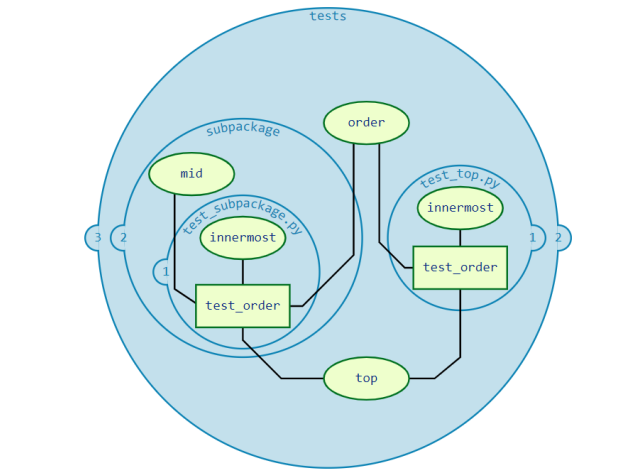您好,登錄后才能下訂單哦!
您好,登錄后才能下訂單哦!
這篇文章主要介紹“怎么用pytest解讀fixture有效性及跨文件共享fixtures”,在日常操作中,相信很多人在怎么用pytest解讀fixture有效性及跨文件共享fixtures問題上存在疑惑,小編查閱了各式資料,整理出簡單好用的操作方法,希望對大家解答”怎么用pytest解讀fixture有效性及跨文件共享fixtures”的疑惑有所幫助!接下來,請跟著小編一起來學習吧!
fixture有效性,說白了就是fixture函數只有在它定義的使用范圍內,才可以被請求到。比如,在類里面定義了一個fixture,
那么就只能是這個類中的測試函數才可以請求。但是,如果一個fixture定義的范圍是整個模塊,那么這個模塊下的每個測試函數都可以去請求。
這里還有另一個影響fixture有效性的參數autouse=True,默認為False,等于True的話會在其他fixture之前先執行該fixture,后面有需要另起一篇,這里簡短帶過。
另外,一個fixture函數還可以請求任何其他的fixture函數。不管被請求的那個fixture函數在哪里定義,只要測試函數請求了它們,fixture函數就可以。
看示例代碼(為了更直觀的看效果,在官方代碼基礎上我加了幾個fixture函數的print):
# content of test_module1.py
import pytest
@pytest.fixture
def order():
print("\n運行fixture函數-order")
return []
@pytest.fixture
def outer(order, inner):
print("運行fixture函數-outer")
order.append("outer")
class TestOne:
@pytest.fixture
def inner(self, order):
print("運行TestOne下的fixture-inner")
order.append("one")
def test_order(self, order, outer):
assert order == ["one", "outer"]
class TestTwo:
@pytest.fixture
def inner(self, order):
print("運行TestTwo下的fixture-inner")
order.append("two")
def test_order(self, order, outer):
assert order == ["two", "outer"]注意:
這里有一個fixture函數outer在測試類的外部
另外還有2個名字都叫inner的fixture函數,分別在測試類TestOne和TestTwo中。
在外部的fixture函數outer中,又請求了內部的fixture函數inner。
現在我只運行類TestOne,看運行結果:
test_module1.py 運行fixture函數-order 運行TestOne下的fixture-inner 運行fixture函數-outer . [100%] ============================== 1 passed in 0.01s ============================== Process finished with exit code 0
說明測試函數里的斷言通過。測試函數執行的時候,外部outer請求的inner是TestOne下的。
雖然TestOne類下的inner,只能作用于TestOne下的測試函數。但是,由于測試函數請求了
外部的outer,所以,外部的outer也就可以請到內部的inner。
官方還給出一個示意圖,可以結合著上述的思路,理解一下。

注意,fixture定義的范圍與它將被實例化的順序無關:實例化順序由調用邏輯強制執行(可以參考這篇)。
如果你把fixture函數放到conftest.py文件中,那么在這個文件所在的整個目錄下,都可以直接請求里面的fixture,不需要導入。
在實際場景中,我們的測試目錄或者包可能有多層的嵌套,這種情況下,每個目錄都可以有一個自己的conftest文件。
比如,像這樣:

各層級里的內容是這樣的:
tests/
__init__.py
conftest.py
# content of tests/conftest.py
import pytest
@pytest.fixture
def order():
return []
@pytest.fixture
def top(order, innermost):
order.append("top")
test_top.py
# content of tests/test_top.py
import pytest
@pytest.fixture
def innermost(order):
order.append("innermost top")
def test_order(order, top):
assert order == ["innermost top", "top"]
subpackage/
__init__.py
conftest.py
# content of tests/subpackage/conftest.py
import pytest
@pytest.fixture
def mid(order):
order.append("mid subpackage")
test_subpackage.py
# content of tests/subpackage/test_subpackage.py
import pytest
@pytest.fixture
def innermost(order, mid):
order.append("innermost subpackage")
def test_order(order, top):
assert order == ["mid subpackage", "innermost subpackage", "top"]同樣的,這里也有一張作用域邊界圖幫助理解。

知識點:
頂層下的conftest里的order和top對當前層和下層級的所有可用(一個圈就對應各自的作用域)。
測試函數只可以向上層級搜索可用的fixture函數(出圈),但是出圈查找的過程中,不能再進到別的圈子向下查找。所以,tests/subpackage/test_subpackage.py::test_order可以找到定義在tests/subpackage/test_subpackage.py里的innermost。但是,另一個定義在tests/test_top.py中,名字也叫innermost的fixture,對test_order來說就不可用了。
其實對于上述,按照我的白話來說,想用conftest里的fixture函數,你只能用同層級或者上層級的。但是上級里的其他兄弟目錄或者包,以及他們的下層級的conftest,你是不能用的。
到此,關于“怎么用pytest解讀fixture有效性及跨文件共享fixtures”的學習就結束了,希望能夠解決大家的疑惑。理論與實踐的搭配能更好的幫助大家學習,快去試試吧!若想繼續學習更多相關知識,請繼續關注億速云網站,小編會繼續努力為大家帶來更多實用的文章!
免責聲明:本站發布的內容(圖片、視頻和文字)以原創、轉載和分享為主,文章觀點不代表本網站立場,如果涉及侵權請聯系站長郵箱:is@yisu.com進行舉報,并提供相關證據,一經查實,將立刻刪除涉嫌侵權內容。